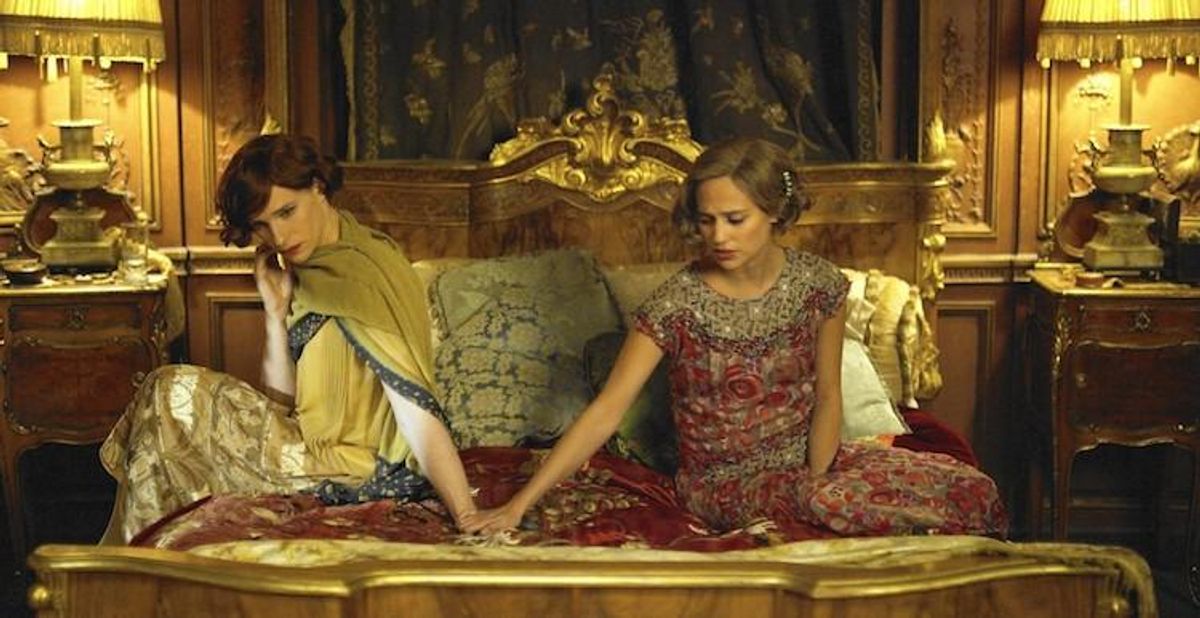In director Tom Hooper's The Danish Girl, we're first introduced to Einar Wegener (Eddie Redmayne) and Gerda (Alicia Vikander) as a loving artistic couple in bohemian 1920s Copenhagen. We penetrate their young domestic bubble--including playful sex scenes--to discover that their typical binary gender roles of husband and wife may not be quite what they first appear.
After Gerda asks Einar to wear silk stockings and strike a feminine pose, it seems some hidden truth has been unleashed. It soon becomes a game for the duo: Gerda teaching Einar to play-act as Lili, an alter ego from which they both seem to derive some creative inspiration, that even spills over into their erotic lives. The intense bond is at the heart of the film, and it's what sustains the narrative throughout.
RELATED | Eddie Redmayne: Changeling
"I think in The Danish Girl, the love in that marriage creates this safe space where the transformation is possible," Hooper explains to Out. "No matter how profound Lili's pain, I feel in that era, she couldn't have contemplated on going on that journey without that support. I keep coming back to this theme of the transformative power of love."
Once Einar dons a dress and exposes himself to the public eye at a party, things really begin to take shape. Introduced as Gerda's cousin, Lili is a curiosity: Will people perceive this is Einar in a dress and red wig, or will they accept her as a legitimate woman?
The male gaze is intense, and Lili/Einar swoons under its intensity. A flirtation from a young man at the party named Henrik (played by Ben Whishaw) is the moment of truth that seems to validate to accept and luxuriate in his true self. But just as Einar is about to experience joy as Lili, the moment is interrupted when she has a sudden nosebleed--a physical manifestation of guilt and shame--and one of the most poignant in the film.
"I have to credit Lucinda Coxon for this, it was there in the script," Hooper says. "We liked the way the blood represented the possibility of menstruation. Eddie immediately connected to it because he sometimes has violent, anxiety-induced nosebleeds when he's very stressed. But is this idea of shame is incredibly key because, when I talk about the balance, it's in some way the balance of joy and shame. In some ways those currents are wed throughout the film."
As Hooper explains it's that fear of shame that compelled Eddie to portray Lili is such a hyper-feminized way. "She is almost overdoing a woman's gestural language and worrying about her appearance," Hooper says. "Later, it's terribly important to me when she discards this red wig she's been using and lets her hair grow out and accepts herself. Without giving too much away, it's why in the final scene she's very unadorned in the end. That journey in a way is all about learning to accept who you are and not be frightened whether other people interpret it in the same way."
Another scene that could have tipped into a feeling of shame is one in which Lili sneaks away to the opera house to pose naked before a mirror. As Redmayne ponders the reflection, the audience is ready for it to be interrupted by someone who will cut this pleasurable experience. But the camera lingers, and shame is never introduced. Hooper says that was intentional. "I felt very passionately that one of the most demanding kind of balancing acts of directing this film was not falling into the trap of only showing the pain of the journey and not showing the joy of the journey," he explains. "If you don't understand the joy of the journey, you won't understand what is calling Lili to be her true self. I didn't want it to be a kind of narrative of: the 'disease of transgender strikes again' and the person is suffering through it."
It's one reason why, despite the fact that some have criticized having a male actor playing a trans woman, it's so powerful witnessing Redmayne transform into Lili and how Gerda reacts with initial empathy and growing frustration. In fact, as much as the film is the story of Lili Elbe, it's also a profound portrait of female power in general.
"I've talked about gender fluidity in relation to Lili, but from the beginning, I thought Gerda was quite interesting in regards of pushing the definition of what gender is," Hooper says. "It's easy to forget, gender is not just what we claim about ourselves, but what and how society constructs it for us. For centuries, women have what their gender is constructed by the patriarchy of men, what I loved about Gerda is here you have a woman in the 1920s saying, 'I'm an artist. I'm openly ambitious. I'm driven. I'm finding my subject, and I'm independent.' Gerda's the one making the money; they have a nice lifestyle because she's an star. Gerda's an early feminist icon who is quite transgressive, but it's easy to forget how transgressive she was. Alicia and I talked about Gerda being a very strong woman and not being a victim."
In fact, both Vikander and Redmayne glow onscreen in Hooper's film as if they are celestial orbs: Vikander's a Gerda a vibrant sun and Redmayne's Lili a luminescent moon. This distinct energy between the two shows different versions of femininity that Hooper says was intentional. "Gerda has a masculinity in her," he says. "That's what's fascinating: Lili doesn't aspire to be a woman like Gerda. She doesn't imitate Gerda's movements; she wants to be much more feminine than Gerda. They're not trying to become versions of each other."
A process of separating takes place through the course of the narrative. At one point we even see them in bed together, now separated by a gauzy sheet--"I wanted to show that Gerda was alert to the fact that Lili needed privacy and space," Hooper explains--but despite the cleaving, we feel certain that these two women will remain bound no matter the trajectory, no longer allowing shame to seep in, attempting to luxuriate in whatever joy the world may allow.
The Danish Girl is in theaters November 27.

























































































Did 'The White Lotus' waste Lisa's acting debut?